Cross-Cultural Management: Australian-Japanese Business Report
VerifiedAdded on 2020/03/16
|10
|2611
|45
Report
AI Summary
This report provides a comprehensive analysis of cross-cultural management, specifically focusing on the business relationship between Australia and Japan. It begins with an executive summary, followed by an introduction that defines culture and its importance in business, especially in the context of globalization. The report then delves into the cultural differences between Australia and Japan, examining these differences through the lens of Hofstede's cultural dimensions. It highlights the disparities in power distance, individualism, masculinity, uncertainty avoidance, long-term orientation, and indulgence. Furthermore, the report explores the cultural and communication challenges that arise between the two countries, offering practical recommendations for Australians to navigate these differences effectively when doing business with Japanese entities. The report emphasizes the importance of understanding linguistic differences, non-verbal communication, preferences in communication styles, and the significance of hierarchy and privacy in Japanese culture. It concludes by summarizing the key takeaways and reinforcing the need for cultural sensitivity in international business interactions.

CROSS CULTURAL MANAGEMENT
Paraphrase This Document
Need a fresh take? Get an instant paraphrase of this document with our AI Paraphraser
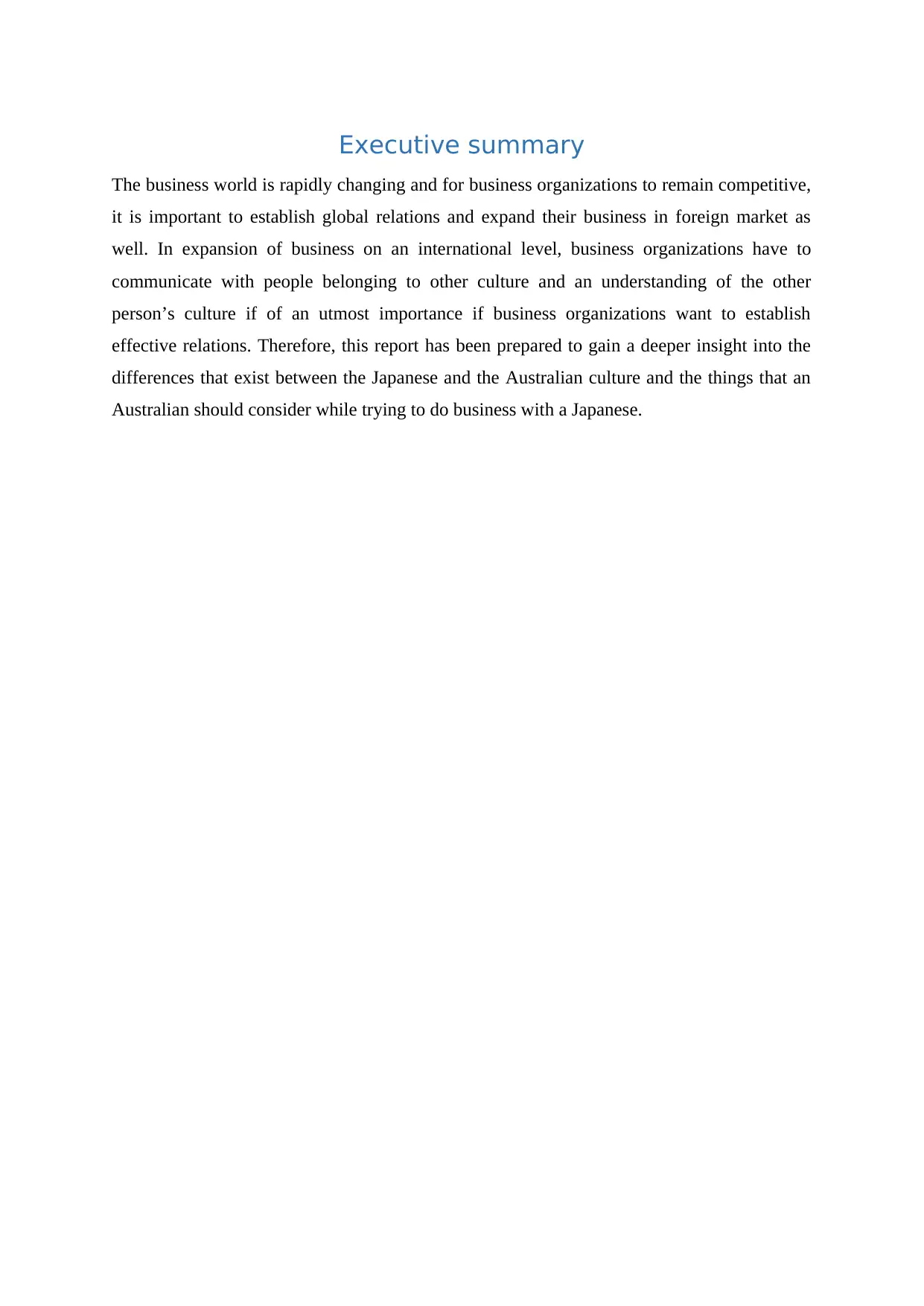
Executive summary
The business world is rapidly changing and for business organizations to remain competitive,
it is important to establish global relations and expand their business in foreign market as
well. In expansion of business on an international level, business organizations have to
communicate with people belonging to other culture and an understanding of the other
person’s culture if of an utmost importance if business organizations want to establish
effective relations. Therefore, this report has been prepared to gain a deeper insight into the
differences that exist between the Japanese and the Australian culture and the things that an
Australian should consider while trying to do business with a Japanese.
The business world is rapidly changing and for business organizations to remain competitive,
it is important to establish global relations and expand their business in foreign market as
well. In expansion of business on an international level, business organizations have to
communicate with people belonging to other culture and an understanding of the other
person’s culture if of an utmost importance if business organizations want to establish
effective relations. Therefore, this report has been prepared to gain a deeper insight into the
differences that exist between the Japanese and the Australian culture and the things that an
Australian should consider while trying to do business with a Japanese.
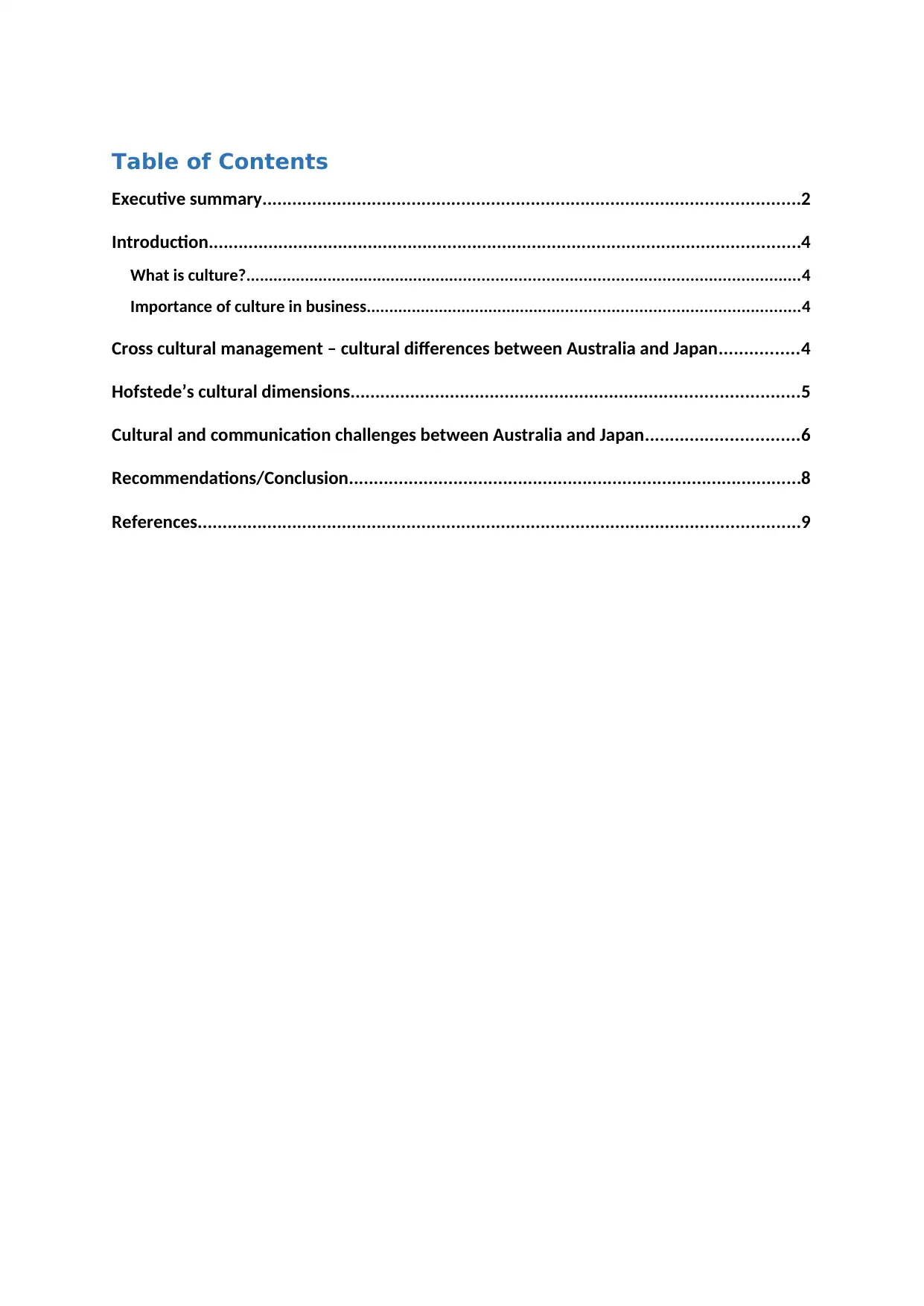
Table of Contents
Executive summary............................................................................................................2
Introduction.......................................................................................................................4
What is culture?.........................................................................................................................4
Importance of culture in business...............................................................................................4
Cross cultural management – cultural differences between Australia and Japan................4
Hofstede’s cultural dimensions..........................................................................................5
Cultural and communication challenges between Australia and Japan...............................6
Recommendations/Conclusion...........................................................................................8
References.........................................................................................................................9
Executive summary............................................................................................................2
Introduction.......................................................................................................................4
What is culture?.........................................................................................................................4
Importance of culture in business...............................................................................................4
Cross cultural management – cultural differences between Australia and Japan................4
Hofstede’s cultural dimensions..........................................................................................5
Cultural and communication challenges between Australia and Japan...............................6
Recommendations/Conclusion...........................................................................................8
References.........................................................................................................................9
⊘ This is a preview!⊘
Do you want full access?
Subscribe today to unlock all pages.

Trusted by 1+ million students worldwide
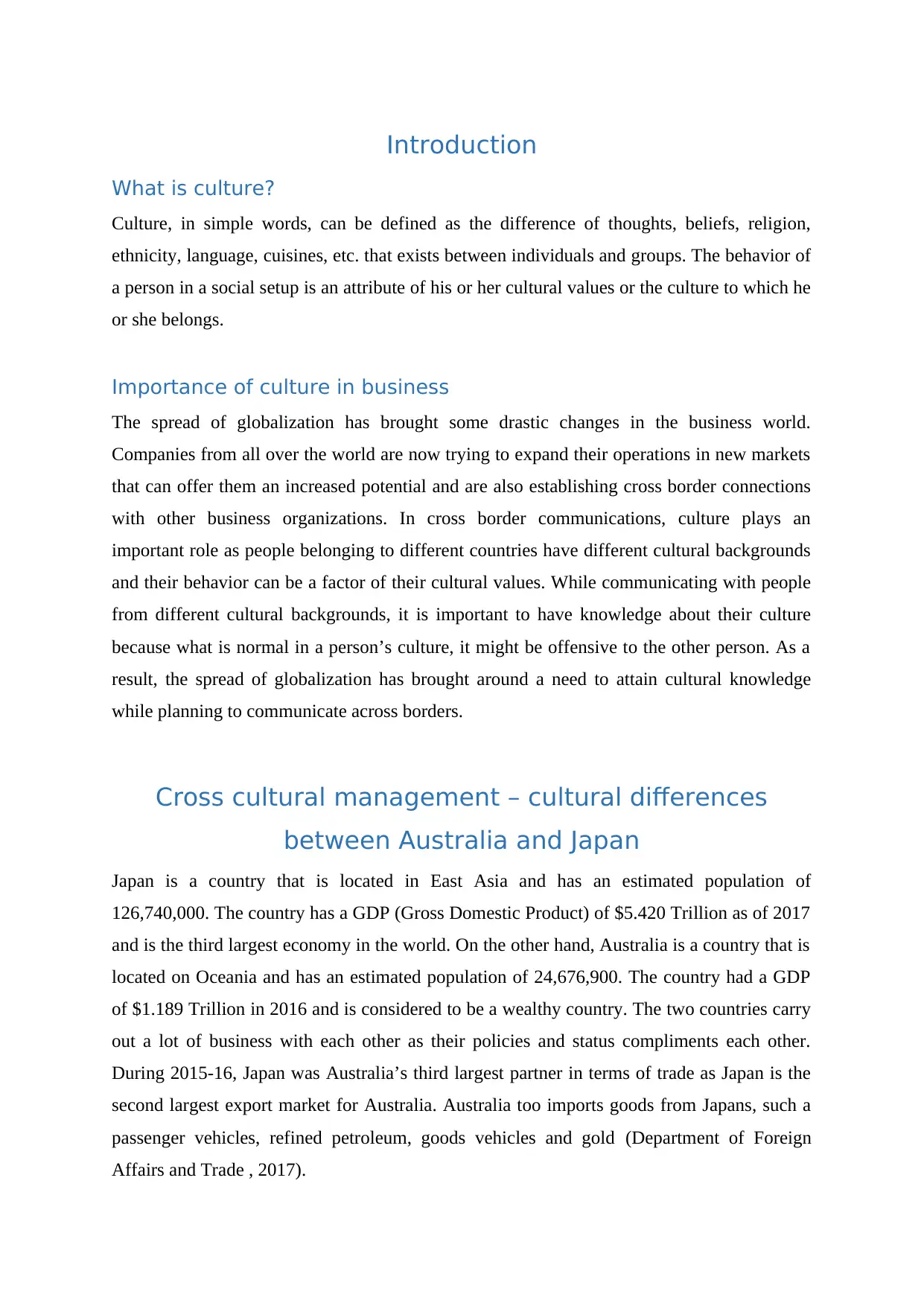
Introduction
What is culture?
Culture, in simple words, can be defined as the difference of thoughts, beliefs, religion,
ethnicity, language, cuisines, etc. that exists between individuals and groups. The behavior of
a person in a social setup is an attribute of his or her cultural values or the culture to which he
or she belongs.
Importance of culture in business
The spread of globalization has brought some drastic changes in the business world.
Companies from all over the world are now trying to expand their operations in new markets
that can offer them an increased potential and are also establishing cross border connections
with other business organizations. In cross border communications, culture plays an
important role as people belonging to different countries have different cultural backgrounds
and their behavior can be a factor of their cultural values. While communicating with people
from different cultural backgrounds, it is important to have knowledge about their culture
because what is normal in a person’s culture, it might be offensive to the other person. As a
result, the spread of globalization has brought around a need to attain cultural knowledge
while planning to communicate across borders.
Cross cultural management – cultural differences
between Australia and Japan
Japan is a country that is located in East Asia and has an estimated population of
126,740,000. The country has a GDP (Gross Domestic Product) of $5.420 Trillion as of 2017
and is the third largest economy in the world. On the other hand, Australia is a country that is
located on Oceania and has an estimated population of 24,676,900. The country had a GDP
of $1.189 Trillion in 2016 and is considered to be a wealthy country. The two countries carry
out a lot of business with each other as their policies and status compliments each other.
During 2015-16, Japan was Australia’s third largest partner in terms of trade as Japan is the
second largest export market for Australia. Australia too imports goods from Japans, such a
passenger vehicles, refined petroleum, goods vehicles and gold (Department of Foreign
Affairs and Trade , 2017).
What is culture?
Culture, in simple words, can be defined as the difference of thoughts, beliefs, religion,
ethnicity, language, cuisines, etc. that exists between individuals and groups. The behavior of
a person in a social setup is an attribute of his or her cultural values or the culture to which he
or she belongs.
Importance of culture in business
The spread of globalization has brought some drastic changes in the business world.
Companies from all over the world are now trying to expand their operations in new markets
that can offer them an increased potential and are also establishing cross border connections
with other business organizations. In cross border communications, culture plays an
important role as people belonging to different countries have different cultural backgrounds
and their behavior can be a factor of their cultural values. While communicating with people
from different cultural backgrounds, it is important to have knowledge about their culture
because what is normal in a person’s culture, it might be offensive to the other person. As a
result, the spread of globalization has brought around a need to attain cultural knowledge
while planning to communicate across borders.
Cross cultural management – cultural differences
between Australia and Japan
Japan is a country that is located in East Asia and has an estimated population of
126,740,000. The country has a GDP (Gross Domestic Product) of $5.420 Trillion as of 2017
and is the third largest economy in the world. On the other hand, Australia is a country that is
located on Oceania and has an estimated population of 24,676,900. The country had a GDP
of $1.189 Trillion in 2016 and is considered to be a wealthy country. The two countries carry
out a lot of business with each other as their policies and status compliments each other.
During 2015-16, Japan was Australia’s third largest partner in terms of trade as Japan is the
second largest export market for Australia. Australia too imports goods from Japans, such a
passenger vehicles, refined petroleum, goods vehicles and gold (Department of Foreign
Affairs and Trade , 2017).
Paraphrase This Document
Need a fresh take? Get an instant paraphrase of this document with our AI Paraphraser
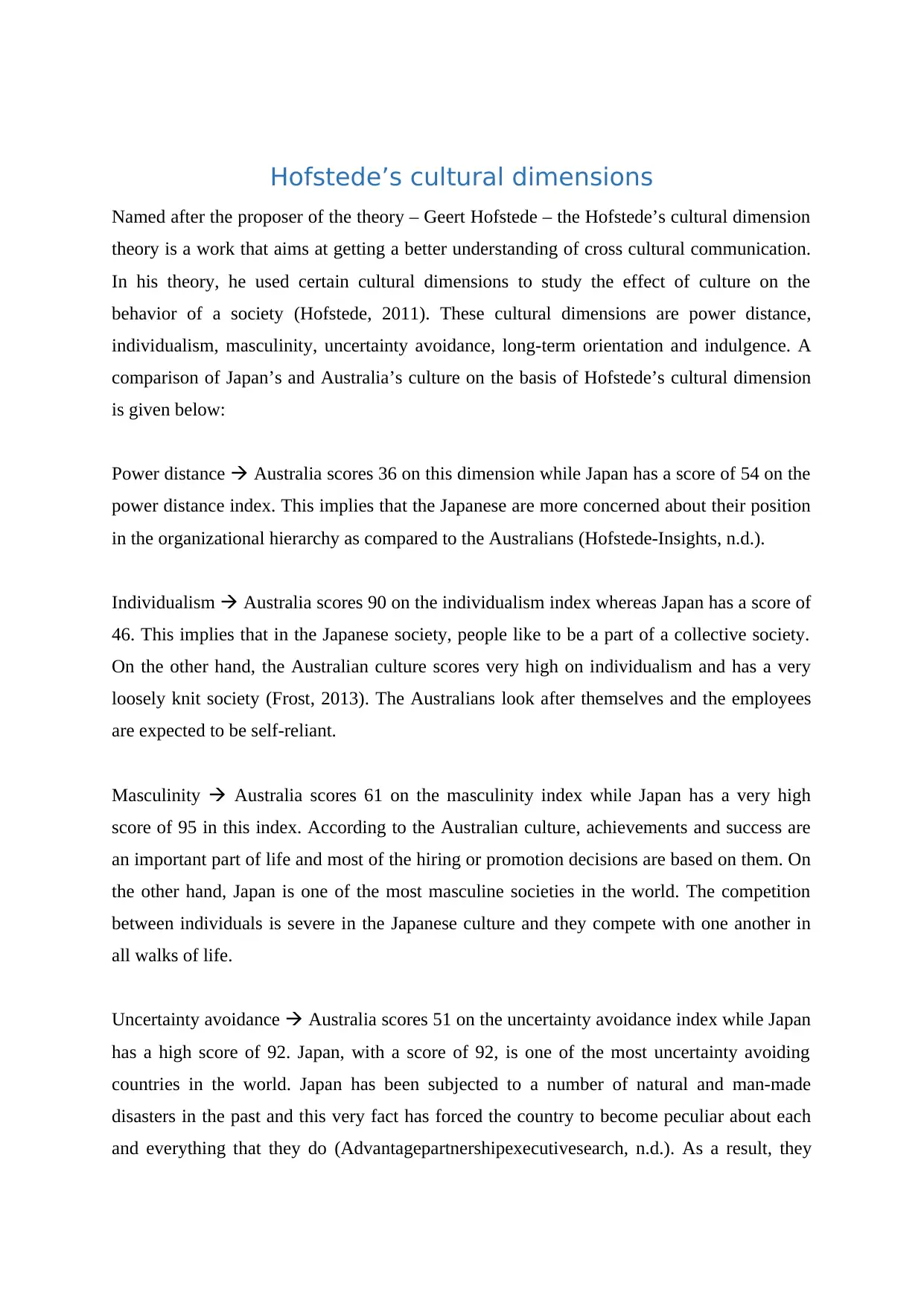
Hofstede’s cultural dimensions
Named after the proposer of the theory – Geert Hofstede – the Hofstede’s cultural dimension
theory is a work that aims at getting a better understanding of cross cultural communication.
In his theory, he used certain cultural dimensions to study the effect of culture on the
behavior of a society (Hofstede, 2011). These cultural dimensions are power distance,
individualism, masculinity, uncertainty avoidance, long-term orientation and indulgence. A
comparison of Japan’s and Australia’s culture on the basis of Hofstede’s cultural dimension
is given below:
Power distance Australia scores 36 on this dimension while Japan has a score of 54 on the
power distance index. This implies that the Japanese are more concerned about their position
in the organizational hierarchy as compared to the Australians (Hofstede-Insights, n.d.).
Individualism Australia scores 90 on the individualism index whereas Japan has a score of
46. This implies that in the Japanese society, people like to be a part of a collective society.
On the other hand, the Australian culture scores very high on individualism and has a very
loosely knit society (Frost, 2013). The Australians look after themselves and the employees
are expected to be self-reliant.
Masculinity Australia scores 61 on the masculinity index while Japan has a very high
score of 95 in this index. According to the Australian culture, achievements and success are
an important part of life and most of the hiring or promotion decisions are based on them. On
the other hand, Japan is one of the most masculine societies in the world. The competition
between individuals is severe in the Japanese culture and they compete with one another in
all walks of life.
Uncertainty avoidance Australia scores 51 on the uncertainty avoidance index while Japan
has a high score of 92. Japan, with a score of 92, is one of the most uncertainty avoiding
countries in the world. Japan has been subjected to a number of natural and man-made
disasters in the past and this very fact has forced the country to become peculiar about each
and everything that they do (Advantagepartnershipexecutivesearch, n.d.). As a result, they
Named after the proposer of the theory – Geert Hofstede – the Hofstede’s cultural dimension
theory is a work that aims at getting a better understanding of cross cultural communication.
In his theory, he used certain cultural dimensions to study the effect of culture on the
behavior of a society (Hofstede, 2011). These cultural dimensions are power distance,
individualism, masculinity, uncertainty avoidance, long-term orientation and indulgence. A
comparison of Japan’s and Australia’s culture on the basis of Hofstede’s cultural dimension
is given below:
Power distance Australia scores 36 on this dimension while Japan has a score of 54 on the
power distance index. This implies that the Japanese are more concerned about their position
in the organizational hierarchy as compared to the Australians (Hofstede-Insights, n.d.).
Individualism Australia scores 90 on the individualism index whereas Japan has a score of
46. This implies that in the Japanese society, people like to be a part of a collective society.
On the other hand, the Australian culture scores very high on individualism and has a very
loosely knit society (Frost, 2013). The Australians look after themselves and the employees
are expected to be self-reliant.
Masculinity Australia scores 61 on the masculinity index while Japan has a very high
score of 95 in this index. According to the Australian culture, achievements and success are
an important part of life and most of the hiring or promotion decisions are based on them. On
the other hand, Japan is one of the most masculine societies in the world. The competition
between individuals is severe in the Japanese culture and they compete with one another in
all walks of life.
Uncertainty avoidance Australia scores 51 on the uncertainty avoidance index while Japan
has a high score of 92. Japan, with a score of 92, is one of the most uncertainty avoiding
countries in the world. Japan has been subjected to a number of natural and man-made
disasters in the past and this very fact has forced the country to become peculiar about each
and everything that they do (Advantagepartnershipexecutivesearch, n.d.). As a result, they
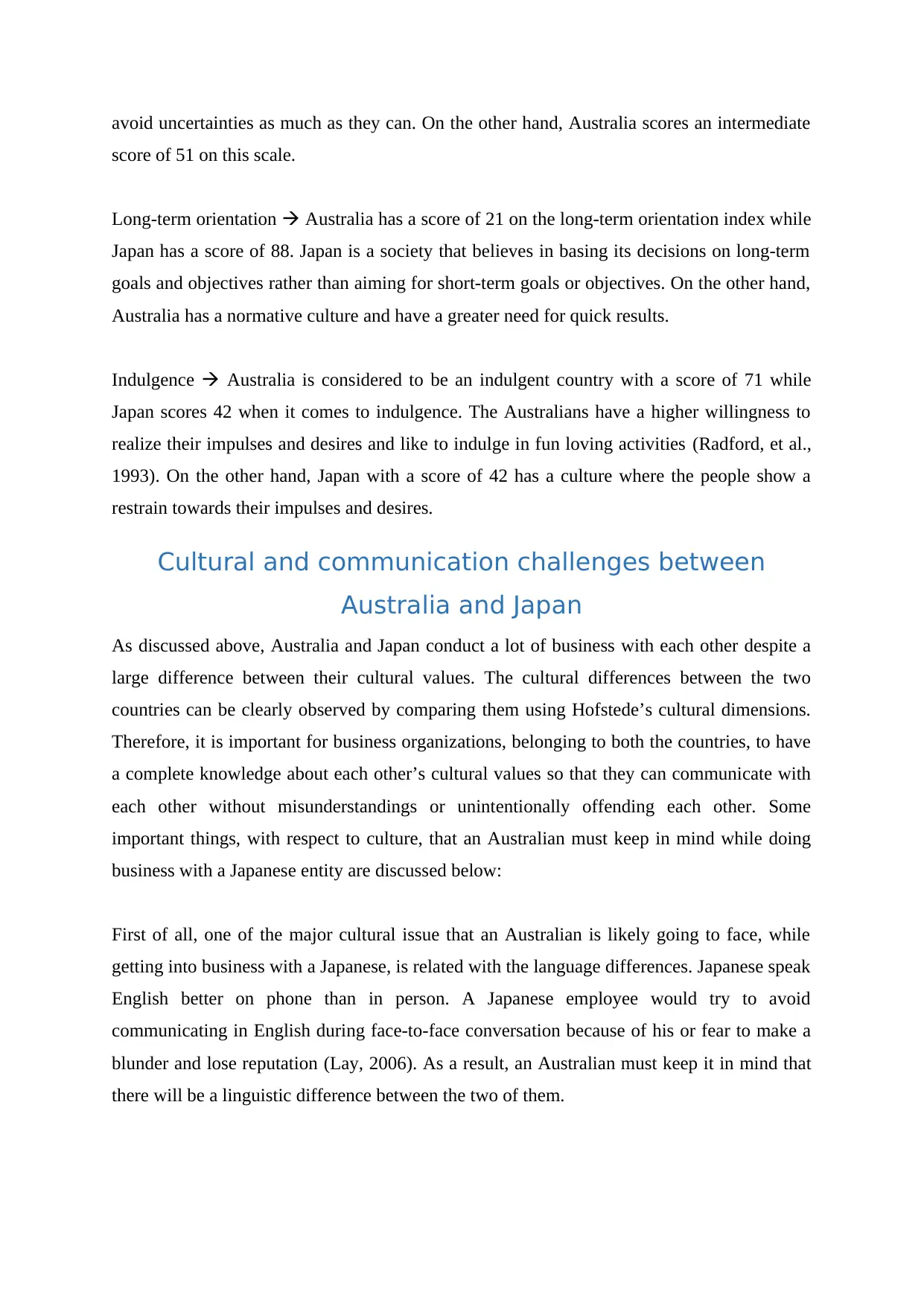
avoid uncertainties as much as they can. On the other hand, Australia scores an intermediate
score of 51 on this scale.
Long-term orientation Australia has a score of 21 on the long-term orientation index while
Japan has a score of 88. Japan is a society that believes in basing its decisions on long-term
goals and objectives rather than aiming for short-term goals or objectives. On the other hand,
Australia has a normative culture and have a greater need for quick results.
Indulgence Australia is considered to be an indulgent country with a score of 71 while
Japan scores 42 when it comes to indulgence. The Australians have a higher willingness to
realize their impulses and desires and like to indulge in fun loving activities (Radford, et al.,
1993). On the other hand, Japan with a score of 42 has a culture where the people show a
restrain towards their impulses and desires.
Cultural and communication challenges between
Australia and Japan
As discussed above, Australia and Japan conduct a lot of business with each other despite a
large difference between their cultural values. The cultural differences between the two
countries can be clearly observed by comparing them using Hofstede’s cultural dimensions.
Therefore, it is important for business organizations, belonging to both the countries, to have
a complete knowledge about each other’s cultural values so that they can communicate with
each other without misunderstandings or unintentionally offending each other. Some
important things, with respect to culture, that an Australian must keep in mind while doing
business with a Japanese entity are discussed below:
First of all, one of the major cultural issue that an Australian is likely going to face, while
getting into business with a Japanese, is related with the language differences. Japanese speak
English better on phone than in person. A Japanese employee would try to avoid
communicating in English during face-to-face conversation because of his or fear to make a
blunder and lose reputation (Lay, 2006). As a result, an Australian must keep it in mind that
there will be a linguistic difference between the two of them.
score of 51 on this scale.
Long-term orientation Australia has a score of 21 on the long-term orientation index while
Japan has a score of 88. Japan is a society that believes in basing its decisions on long-term
goals and objectives rather than aiming for short-term goals or objectives. On the other hand,
Australia has a normative culture and have a greater need for quick results.
Indulgence Australia is considered to be an indulgent country with a score of 71 while
Japan scores 42 when it comes to indulgence. The Australians have a higher willingness to
realize their impulses and desires and like to indulge in fun loving activities (Radford, et al.,
1993). On the other hand, Japan with a score of 42 has a culture where the people show a
restrain towards their impulses and desires.
Cultural and communication challenges between
Australia and Japan
As discussed above, Australia and Japan conduct a lot of business with each other despite a
large difference between their cultural values. The cultural differences between the two
countries can be clearly observed by comparing them using Hofstede’s cultural dimensions.
Therefore, it is important for business organizations, belonging to both the countries, to have
a complete knowledge about each other’s cultural values so that they can communicate with
each other without misunderstandings or unintentionally offending each other. Some
important things, with respect to culture, that an Australian must keep in mind while doing
business with a Japanese entity are discussed below:
First of all, one of the major cultural issue that an Australian is likely going to face, while
getting into business with a Japanese, is related with the language differences. Japanese speak
English better on phone than in person. A Japanese employee would try to avoid
communicating in English during face-to-face conversation because of his or fear to make a
blunder and lose reputation (Lay, 2006). As a result, an Australian must keep it in mind that
there will be a linguistic difference between the two of them.
⊘ This is a preview!⊘
Do you want full access?
Subscribe today to unlock all pages.

Trusted by 1+ million students worldwide
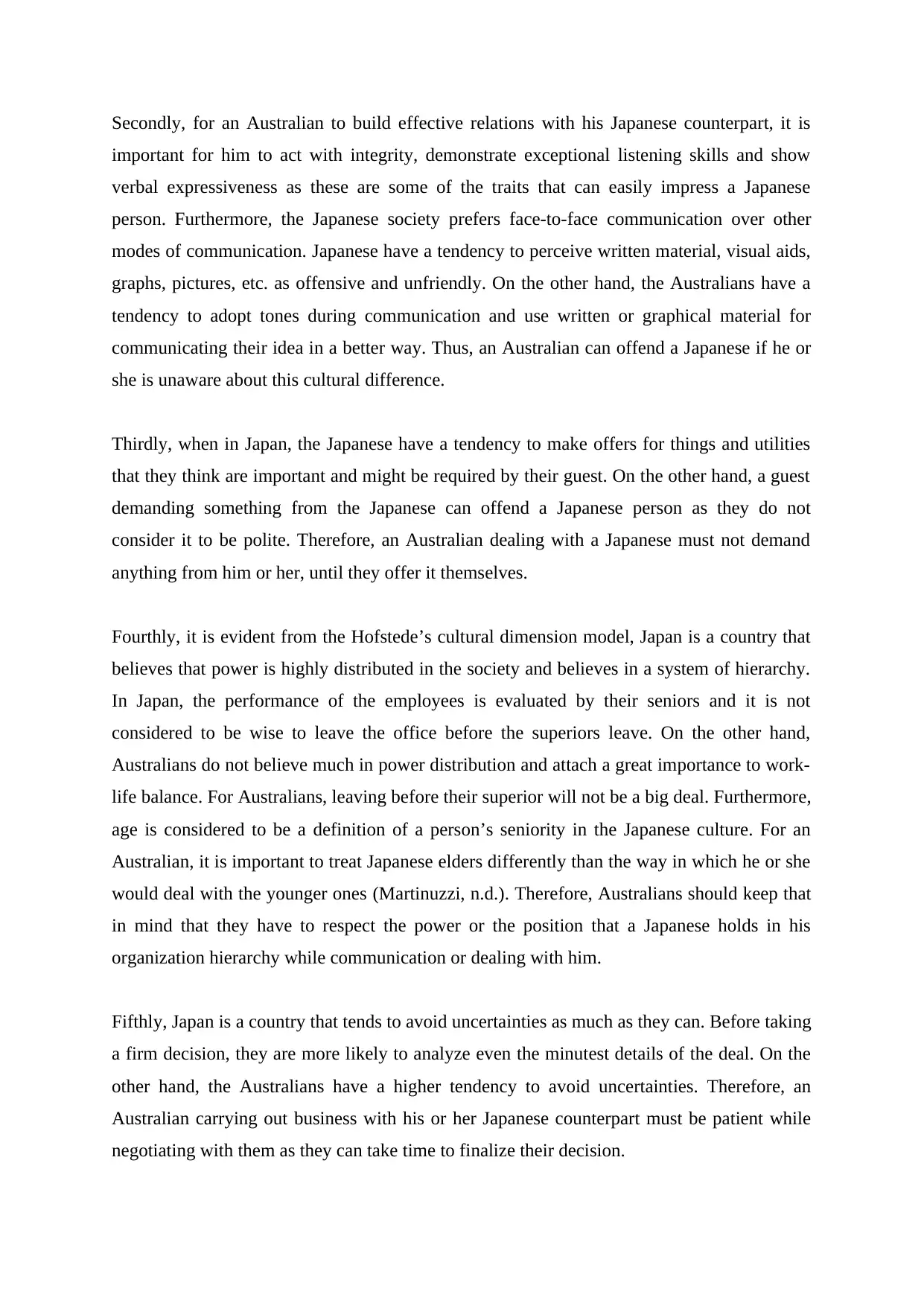
Secondly, for an Australian to build effective relations with his Japanese counterpart, it is
important for him to act with integrity, demonstrate exceptional listening skills and show
verbal expressiveness as these are some of the traits that can easily impress a Japanese
person. Furthermore, the Japanese society prefers face-to-face communication over other
modes of communication. Japanese have a tendency to perceive written material, visual aids,
graphs, pictures, etc. as offensive and unfriendly. On the other hand, the Australians have a
tendency to adopt tones during communication and use written or graphical material for
communicating their idea in a better way. Thus, an Australian can offend a Japanese if he or
she is unaware about this cultural difference.
Thirdly, when in Japan, the Japanese have a tendency to make offers for things and utilities
that they think are important and might be required by their guest. On the other hand, a guest
demanding something from the Japanese can offend a Japanese person as they do not
consider it to be polite. Therefore, an Australian dealing with a Japanese must not demand
anything from him or her, until they offer it themselves.
Fourthly, it is evident from the Hofstede’s cultural dimension model, Japan is a country that
believes that power is highly distributed in the society and believes in a system of hierarchy.
In Japan, the performance of the employees is evaluated by their seniors and it is not
considered to be wise to leave the office before the superiors leave. On the other hand,
Australians do not believe much in power distribution and attach a great importance to work-
life balance. For Australians, leaving before their superior will not be a big deal. Furthermore,
age is considered to be a definition of a person’s seniority in the Japanese culture. For an
Australian, it is important to treat Japanese elders differently than the way in which he or she
would deal with the younger ones (Martinuzzi, n.d.). Therefore, Australians should keep that
in mind that they have to respect the power or the position that a Japanese holds in his
organization hierarchy while communication or dealing with him.
Fifthly, Japan is a country that tends to avoid uncertainties as much as they can. Before taking
a firm decision, they are more likely to analyze even the minutest details of the deal. On the
other hand, the Australians have a higher tendency to avoid uncertainties. Therefore, an
Australian carrying out business with his or her Japanese counterpart must be patient while
negotiating with them as they can take time to finalize their decision.
important for him to act with integrity, demonstrate exceptional listening skills and show
verbal expressiveness as these are some of the traits that can easily impress a Japanese
person. Furthermore, the Japanese society prefers face-to-face communication over other
modes of communication. Japanese have a tendency to perceive written material, visual aids,
graphs, pictures, etc. as offensive and unfriendly. On the other hand, the Australians have a
tendency to adopt tones during communication and use written or graphical material for
communicating their idea in a better way. Thus, an Australian can offend a Japanese if he or
she is unaware about this cultural difference.
Thirdly, when in Japan, the Japanese have a tendency to make offers for things and utilities
that they think are important and might be required by their guest. On the other hand, a guest
demanding something from the Japanese can offend a Japanese person as they do not
consider it to be polite. Therefore, an Australian dealing with a Japanese must not demand
anything from him or her, until they offer it themselves.
Fourthly, it is evident from the Hofstede’s cultural dimension model, Japan is a country that
believes that power is highly distributed in the society and believes in a system of hierarchy.
In Japan, the performance of the employees is evaluated by their seniors and it is not
considered to be wise to leave the office before the superiors leave. On the other hand,
Australians do not believe much in power distribution and attach a great importance to work-
life balance. For Australians, leaving before their superior will not be a big deal. Furthermore,
age is considered to be a definition of a person’s seniority in the Japanese culture. For an
Australian, it is important to treat Japanese elders differently than the way in which he or she
would deal with the younger ones (Martinuzzi, n.d.). Therefore, Australians should keep that
in mind that they have to respect the power or the position that a Japanese holds in his
organization hierarchy while communication or dealing with him.
Fifthly, Japan is a country that tends to avoid uncertainties as much as they can. Before taking
a firm decision, they are more likely to analyze even the minutest details of the deal. On the
other hand, the Australians have a higher tendency to avoid uncertainties. Therefore, an
Australian carrying out business with his or her Japanese counterpart must be patient while
negotiating with them as they can take time to finalize their decision.
Paraphrase This Document
Need a fresh take? Get an instant paraphrase of this document with our AI Paraphraser
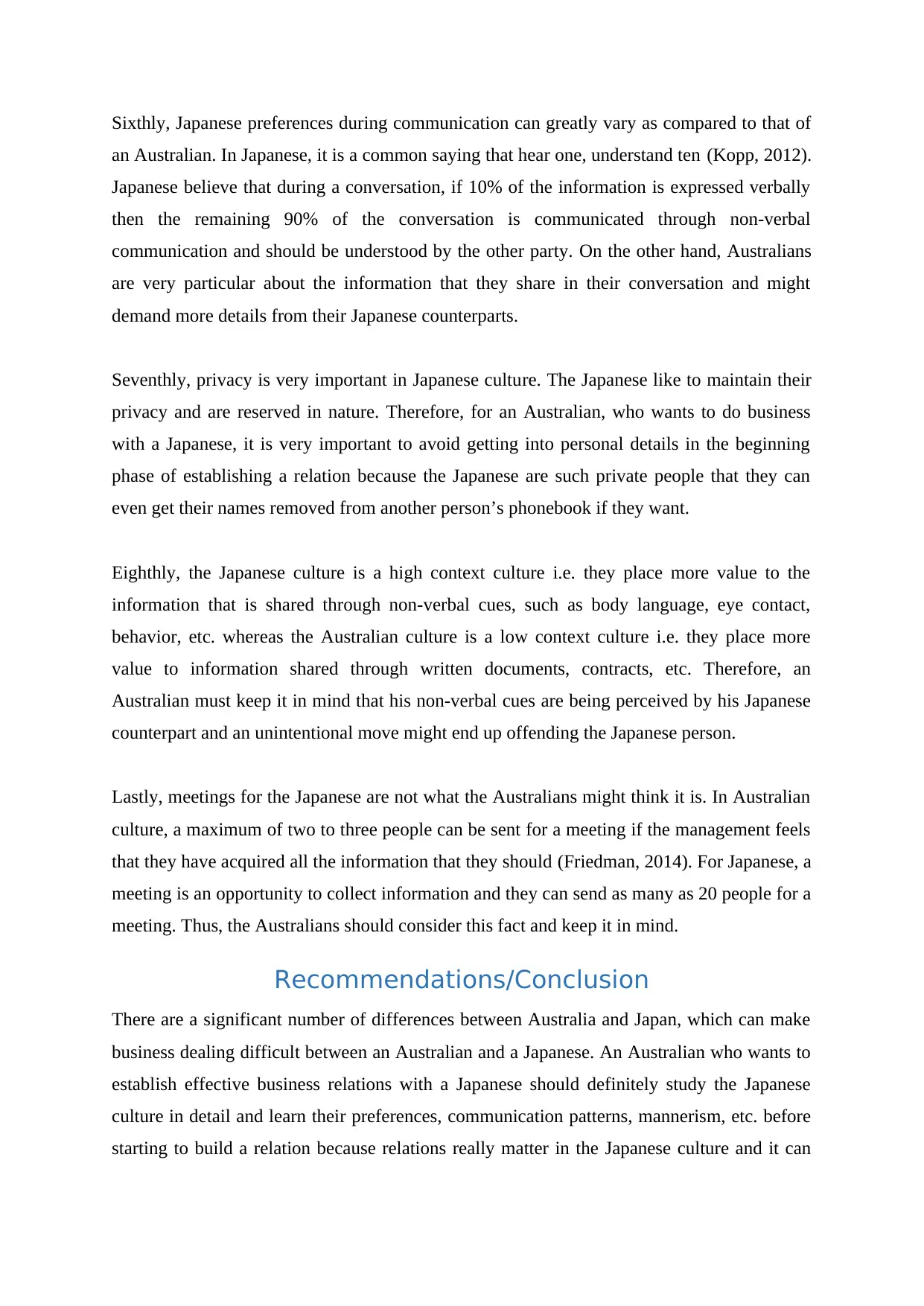
Sixthly, Japanese preferences during communication can greatly vary as compared to that of
an Australian. In Japanese, it is a common saying that hear one, understand ten (Kopp, 2012).
Japanese believe that during a conversation, if 10% of the information is expressed verbally
then the remaining 90% of the conversation is communicated through non-verbal
communication and should be understood by the other party. On the other hand, Australians
are very particular about the information that they share in their conversation and might
demand more details from their Japanese counterparts.
Seventhly, privacy is very important in Japanese culture. The Japanese like to maintain their
privacy and are reserved in nature. Therefore, for an Australian, who wants to do business
with a Japanese, it is very important to avoid getting into personal details in the beginning
phase of establishing a relation because the Japanese are such private people that they can
even get their names removed from another person’s phonebook if they want.
Eighthly, the Japanese culture is a high context culture i.e. they place more value to the
information that is shared through non-verbal cues, such as body language, eye contact,
behavior, etc. whereas the Australian culture is a low context culture i.e. they place more
value to information shared through written documents, contracts, etc. Therefore, an
Australian must keep it in mind that his non-verbal cues are being perceived by his Japanese
counterpart and an unintentional move might end up offending the Japanese person.
Lastly, meetings for the Japanese are not what the Australians might think it is. In Australian
culture, a maximum of two to three people can be sent for a meeting if the management feels
that they have acquired all the information that they should (Friedman, 2014). For Japanese, a
meeting is an opportunity to collect information and they can send as many as 20 people for a
meeting. Thus, the Australians should consider this fact and keep it in mind.
Recommendations/Conclusion
There are a significant number of differences between Australia and Japan, which can make
business dealing difficult between an Australian and a Japanese. An Australian who wants to
establish effective business relations with a Japanese should definitely study the Japanese
culture in detail and learn their preferences, communication patterns, mannerism, etc. before
starting to build a relation because relations really matter in the Japanese culture and it can
an Australian. In Japanese, it is a common saying that hear one, understand ten (Kopp, 2012).
Japanese believe that during a conversation, if 10% of the information is expressed verbally
then the remaining 90% of the conversation is communicated through non-verbal
communication and should be understood by the other party. On the other hand, Australians
are very particular about the information that they share in their conversation and might
demand more details from their Japanese counterparts.
Seventhly, privacy is very important in Japanese culture. The Japanese like to maintain their
privacy and are reserved in nature. Therefore, for an Australian, who wants to do business
with a Japanese, it is very important to avoid getting into personal details in the beginning
phase of establishing a relation because the Japanese are such private people that they can
even get their names removed from another person’s phonebook if they want.
Eighthly, the Japanese culture is a high context culture i.e. they place more value to the
information that is shared through non-verbal cues, such as body language, eye contact,
behavior, etc. whereas the Australian culture is a low context culture i.e. they place more
value to information shared through written documents, contracts, etc. Therefore, an
Australian must keep it in mind that his non-verbal cues are being perceived by his Japanese
counterpart and an unintentional move might end up offending the Japanese person.
Lastly, meetings for the Japanese are not what the Australians might think it is. In Australian
culture, a maximum of two to three people can be sent for a meeting if the management feels
that they have acquired all the information that they should (Friedman, 2014). For Japanese, a
meeting is an opportunity to collect information and they can send as many as 20 people for a
meeting. Thus, the Australians should consider this fact and keep it in mind.
Recommendations/Conclusion
There are a significant number of differences between Australia and Japan, which can make
business dealing difficult between an Australian and a Japanese. An Australian who wants to
establish effective business relations with a Japanese should definitely study the Japanese
culture in detail and learn their preferences, communication patterns, mannerism, etc. before
starting to build a relation because relations really matter in the Japanese culture and it can

become difficult for an Australian to establish effective relations if he or she is not aware
about the Japanese culture.
about the Japanese culture.
⊘ This is a preview!⊘
Do you want full access?
Subscribe today to unlock all pages.

Trusted by 1+ million students worldwide
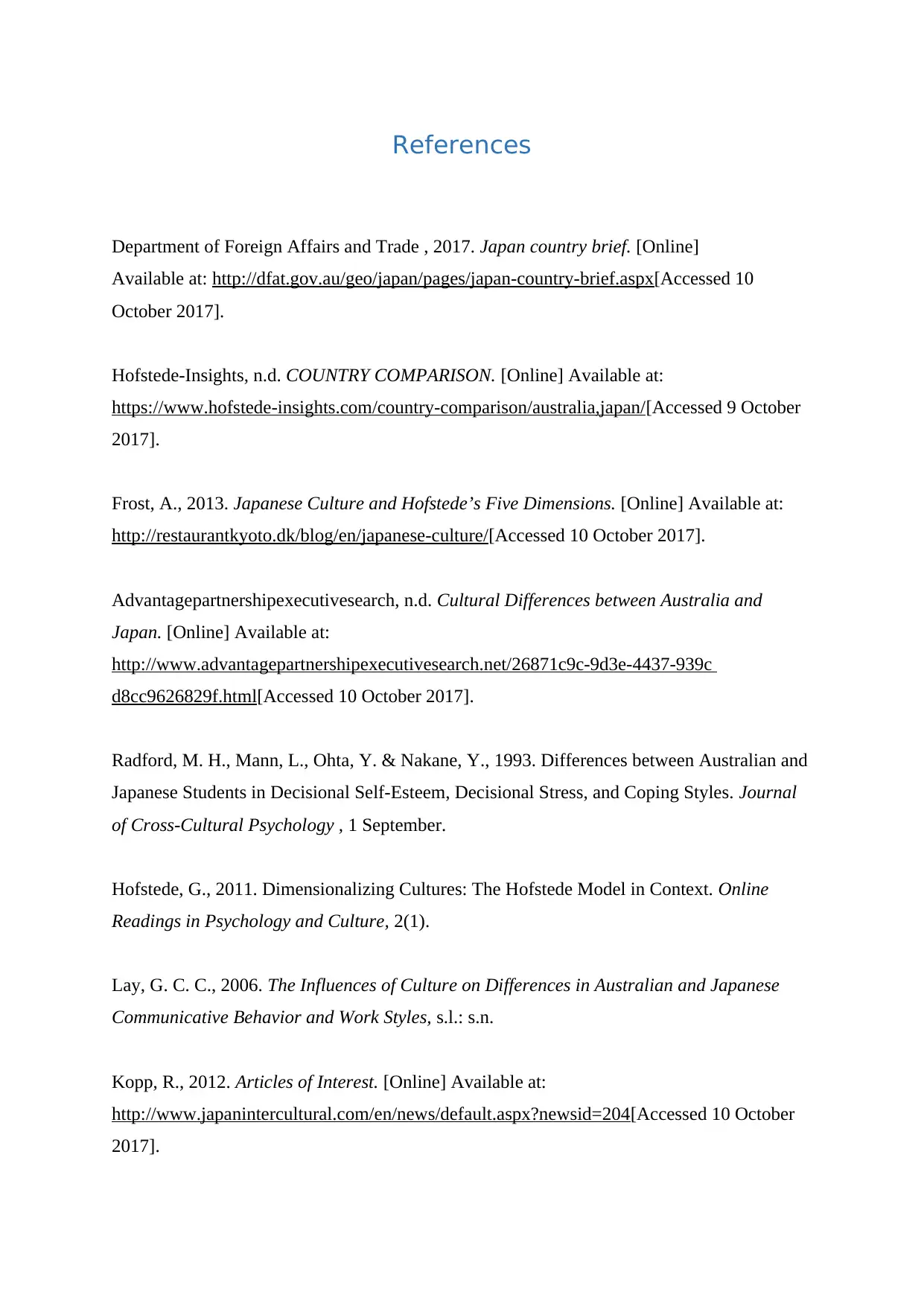
References
Department of Foreign Affairs and Trade , 2017. Japan country brief. [Online]
Available at: http://dfat.gov.au/geo/japan/pages/japan-country-brief.aspx[Accessed 10
October 2017].
Hofstede-Insights, n.d. COUNTRY COMPARISON. [Online] Available at:
https://www.hofstede-insights.com/country-comparison/australia,japan/[Accessed 9 October
2017].
Frost, A., 2013. Japanese Culture and Hofstede’s Five Dimensions. [Online] Available at:
http://restaurantkyoto.dk/blog/en/japanese-culture/[Accessed 10 October 2017].
Advantagepartnershipexecutivesearch, n.d. Cultural Differences between Australia and
Japan. [Online] Available at:
http://www.advantagepartnershipexecutivesearch.net/26871c9c-9d3e-4437-939c
d8cc9626829f.html[Accessed 10 October 2017].
Radford, M. H., Mann, L., Ohta, Y. & Nakane, Y., 1993. Differences between Australian and
Japanese Students in Decisional Self-Esteem, Decisional Stress, and Coping Styles. Journal
of Cross-Cultural Psychology , 1 September.
Hofstede, G., 2011. Dimensionalizing Cultures: The Hofstede Model in Context. Online
Readings in Psychology and Culture, 2(1).
Lay, G. C. C., 2006. The Influences of Culture on Differences in Australian and Japanese
Communicative Behavior and Work Styles, s.l.: s.n.
Kopp, R., 2012. Articles of Interest. [Online] Available at:
http://www.japanintercultural.com/en/news/default.aspx?newsid=204[Accessed 10 October
2017].
Department of Foreign Affairs and Trade , 2017. Japan country brief. [Online]
Available at: http://dfat.gov.au/geo/japan/pages/japan-country-brief.aspx[Accessed 10
October 2017].
Hofstede-Insights, n.d. COUNTRY COMPARISON. [Online] Available at:
https://www.hofstede-insights.com/country-comparison/australia,japan/[Accessed 9 October
2017].
Frost, A., 2013. Japanese Culture and Hofstede’s Five Dimensions. [Online] Available at:
http://restaurantkyoto.dk/blog/en/japanese-culture/[Accessed 10 October 2017].
Advantagepartnershipexecutivesearch, n.d. Cultural Differences between Australia and
Japan. [Online] Available at:
http://www.advantagepartnershipexecutivesearch.net/26871c9c-9d3e-4437-939c
d8cc9626829f.html[Accessed 10 October 2017].
Radford, M. H., Mann, L., Ohta, Y. & Nakane, Y., 1993. Differences between Australian and
Japanese Students in Decisional Self-Esteem, Decisional Stress, and Coping Styles. Journal
of Cross-Cultural Psychology , 1 September.
Hofstede, G., 2011. Dimensionalizing Cultures: The Hofstede Model in Context. Online
Readings in Psychology and Culture, 2(1).
Lay, G. C. C., 2006. The Influences of Culture on Differences in Australian and Japanese
Communicative Behavior and Work Styles, s.l.: s.n.
Kopp, R., 2012. Articles of Interest. [Online] Available at:
http://www.japanintercultural.com/en/news/default.aspx?newsid=204[Accessed 10 October
2017].
1 out of 10
Related Documents
Your All-in-One AI-Powered Toolkit for Academic Success.
+13062052269
info@desklib.com
Available 24*7 on WhatsApp / Email
![[object Object]](/_next/static/media/star-bottom.7253800d.svg)
Unlock your academic potential
Copyright © 2020–2025 A2Z Services. All Rights Reserved. Developed and managed by ZUCOL.





